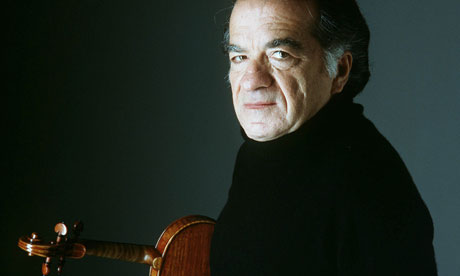
The American violinist Ruggiero Ricci, who has died aged 94, was a virtuoso of the old school – combining technical mastery with exceptional skills as a musical communicator. For him, Niccolò Paganini was the gateway to achieving an unrivalled violinistic technique, and he practised that composer's 24 Caprices to maintain the skills demanded by them, and therefore, as he saw it, the skills required by the violin repertoire as a whole.
He often said that if he felt his technique sliding, then it was back to Paganini to regain his first-class form, with the help of studies, transcriptions of Chopin and Brahms, and scales in octaves and thirds. To balance his love of the 19th-century firework repertoire, Ricci also concentrated on JS Bach, and he would give unaccompanied recitals where he would engage his audiences with Bach and Paganini alternately, completing the unaccompanied output of both composers on successive nights.
Ricci was born in San Francisco into a large Italian-American musical family, and other siblings also went into professional music, although not at their brother's level. From the age of eight he studied with Louis Persinger, then leader of the San Francisco Symphony, and himself a pupil of the great Belgian virtuoso Eugène Ysaÿe. The young Yehudi Menuhin was also taught by Persinger.
A child prodigy, Ricci was giving acclaimed debuts at the age of 10, playing the Mendelssohn concerto in San Francisco and then New York. He undertook his first international tour at the age of 14. Through endless practice, he ensured that what had come so easily to him as a child did not vanish with maturity. Later he ascribed his influences not only to teachers – he also learned with Michel Piastro and Georg Kulenkampff – but to predecessors such as Paganini. Among those whose playing he knew, he singled out Fritz Kreisler and David Oistrakh, particularly for their bowing arms, and the sheer brilliance of Jascha Heifetz, whose spiccato gave him matchless speed.
During the second world war Ricci served in the US army air force as an "entertainment specialist", playing to the troops. Soon after that he made his first recording of Paganini for Vox on 78s, and his reputation as a virtuoso performer was sealed.
Finding that few others tackled Paganini and similarly challenging material – Wieniawski's fiendishly difficult variations on the Russian national anthem, for instance – he learned and performed about 60 concertos. These included standard works such as the Beethoven, for him the most perfectly composed of its genre, and he gave first performances of concertos by Alberto Ginastera (1963) with Leonard Bernstein and the New York Philharmonic, and by Gottfried von Einem (1970) with Seiji Ozawa and the Vienna Philharmonic. He also edited the newly discovered manuscript of Paganini's Fourth Concerto and gave its first modern performance, in 1971. In all, he gave more than 5,000 concerts in 65 countries.
Ricci, like many of his generation, used to complain about the anonymity of modern players and the homogeneity of playing when styles merge into each other. He put this down partly to the speed and ease of air travel, allowing no national identities or schools of playing to be observed or preserved. He berated the rise of competitions for promoting characterless, identikit perfection.
He prided himself that if he played a recording of one of his students – Ricci taught at New York's Juilliard School, and gave many masterclasses at summer schools – he could always identify the performer. He encouraged his students to shop around for their influences, just as he had.
The first violinist to record Paganini's 24 Caprices in their original version, he enjoyed trying to convey on disc something of the white heat of a concert performance. His large output of recordings – more than 500 – includes the concertos by Beethoven (with 14 different cadenzas), Brahms (with 16 cadenzas), Saint-Saëns, Khachaturian and Tchaikovsky.
Ricci played on a 1734 Guarneri del Gesù violin, formerly owned by Bronislav Huberman. For him the Guarneri sound (as opposed to Stradivari) was a matter of preference, able as it was to give the required brilliance, colour and attack that he sought.
Even after retiring from playing when he was 85, he still gave masterclasses and private lessons. His book Ricci on Glissando: The Shortcut to Violin Technique (2008) explains advanced lefthand technique, with exercises and advice on how to cultivate a fixed-thumb position through the practice of various scales, summarising how to make the impossible seem almost possible.
In later years Ricci suffered from painful joints and needed the heat and dry climate of the Californian desert. He married his third wife, Julia, in 1978, and had two sons and three daughters.
• Ruggiero Ricci, violinist, born 24 July 1918; died 6 August 2012

